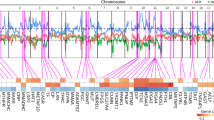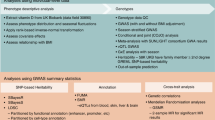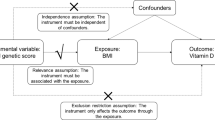Abstract
Background/objectives
Familial correlation of serum 25-hydroxyvitamin D concentration (25(OH)D) was reported in twin- or parent-offspring studies. However, data on relative contribution of environmental factors on familial clustering of 25(OH)D in extended families are limited.
Subjects/methods
We performed cross-sectional study using data from the Korean National Health and Nutrition Examination Survey (KNHANES) 2008–2012. Familial correlations of 25(OH)D were estimated in 28,551 subjects from 10,882 families. The variance component method was used to assess the relative contribution of additive genetic or environmental contributions to the variation in 25(OH)D level. Logistic regression models with interaction term were built to evaluate the differential influence of parental vitamin D status on the adolescents and adults offspring.
Results
Mean serum 25(OH)D concentration of subjects was 44.6 nmol/L (vitamin D insufficiency (30–50 nmol/L), 51%; vitamin D deficiency ( < 30 nmol/L), 17%). Familial clustering explained 40% of the total variation in 25(OH)D. In the variance component model, 4%, 39%, and 57% of the variation in serum 25(OH)D level was attributed to additive genetic, common shared environmental, and individual environmental factors, respectively. The odds of vitamin D deficiency in offspring with both parents with vitamin D deficiency compared with those with both parents with sufficient vitamin D levels was greater in adolescents ( < 19 years) than in adults ( ≥ 19 years) (odds ratio = 41.1 vs. 12.5; p for interaction = 0.03).
Conclusions
We found a familial clustering of vitamin D deficiency in a large family-based cohort. Parental influence on vitamin D status of offspring was greater in adolescents than in adults.
This is a preview of subscription content, access via your institution
Access options
Subscribe to this journal
Receive 12 print issues and online access
$259.00 per year
only $21.58 per issue
Buy this article
- Purchase on Springer Link
- Instant access to full article PDF
Prices may be subject to local taxes which are calculated during checkout



Similar content being viewed by others
References
Dawson-Hughes B, Bischoff-Ferrari HA. Therapy of osteoporosis with calcium and vitamin D. J Bone Miner Res. 2007;22(Suppl 2):V59–63. https://doi.org/10.1359/jbmr.07s209
Holick MF. Vitamin D deficiency. N Engl J Med. 2007;357:266–81. https://doi.org/10.1056/NEJMra070553
Muscogiuri G. New light on an old vitamin: The role of the sunshine vitamin D in chronic disease. Rev Endocr Metab Disord. 2017;18:145–7. https://doi.org/10.1007/s11154-017-9427-y
Savastano S, Barrea L, Savanelli MC, Nappi F, Di Somma C, Orio F, et al. Low vitamin D status and obesity: Role of nutritionist. Rev Endocr Metab Disord. 2017;18:215–25. https://doi.org/10.1007/s11154-017-9410-7
Muscogiuri G, Altieri B, de Angelis C, Palomba S, Pivonello R, Colao A, et al. Shedding new light on female fertility: The role of vitamin D. Rev Endocr Metab Disord. 2017;18:273–83. https://doi.org/10.1007/s11154-017-9407-2
Ullah MI, Koch CA, Tamanna S, Rouf S, Shamsuddin L. Vitamin D deficiency and the risk of preeclampsia and eclampsia in Bangladesh. Horm Metab Res. 2013;45:682–7. https://doi.org/10.1055/s-0033-1345199
Ullah MI, Uwaifo GI, Nicholas WC, Koch CA. Does vitamin d deficiency cause hypertension? Current evidence from clinical studies and potential mechanisms. Int J Endocrinol. 2010;2010:579640. https://doi.org/10.1155/2010/579640
Holick MF. The vitamin D deficiency pandemic: approaches for diagnosis, treatment and prevention. Rev Endocr Metab Disord. 2017;18:153–65. https://doi.org/10.1007/s11154-017-9424-1
Karohl C, Su S, Kumari M, Tangpricha V, Veledar E, Vaccarino V, et al. Heritability and seasonal variability of vitamin D concentrations in male twins. Am J Clin Nutr. 2010;92:1393–8. https://doi.org/10.3945/ajcn.2010.30176
Snellman G, Melhus H, Gedeborg R, Olofsson S, Wolk A, Pedersen NL, et al. Seasonal genetic influence on serum 25-hydroxyvitamin D levels: a twin study. PLoS ONE. 2009;4:e7747. https://doi.org/10.1371/journal.pone.0007747
Arguelles LM, Langman CB, Ariza AJ, Ali FN, Dilley K, Price H, et al. Heritability and environmental factors affecting vitamin D status in rural Chinese adolescent twins. J Clin Endocrinol Metab. 2009;94:3273–81. https://doi.org/10.1210/jc.2008-1532
Hunter D, De Lange M, Snieder H, MacGregor AJ, Swaminathan R, Thakker RV, et al. Genetic contribution to bone metabolism, calcium excretion, and vitamin D and parathyroid hormone regulation. J Bone Miner Res. 2001;16:371–8. https://doi.org/10.1359/jbmr.2001.16.2.371
Wang TJ, Zhang F, Richards JB, Kestenbaum B, van Meurs JB, Berry D, et al. Common genetic determinants of vitamin D insufficiency: a genome-wide association study. Lancet. 2010;376:180–8. https://doi.org/10.1016/s0140-6736(10)60588-0
Madsen KH, Rasmussen LB, Mejborn H, Andersen EW, Molgaard C, Nissen J, et al. Vitamin D status and its determinants in children and adults among families in late summer in Denmark. Br J Nutr. 2014;112:776–84. https://doi.org/10.1017/S0007114514001263
Park SI, Rhee Y, Lim JS, Park S, Kang SW, Lee MS, et al. Right adrenal venography findings correlated with C-arm CT for selection during C-arm CT-assisted adrenal vein sampling in primary aldosteronism. Cardiovasc Interv Radiol. 2014;37:1469–75. https://doi.org/10.1007/s00270-013-0820-y
Robinson SL, Ramirez-Zea M, Roman AV, Villamor E. Nine Mesoamerican Countries Metabolic Syndrome Study G. Correlates and family aggregation of vitamin D concentrations in school-aged children and their parents in nine Mesoamerican countries. Public Health Nutr. 2017;20:2754–65. https://doi.org/10.1017/S1368980017001616
Livshits G, Karasik D, Seibel MJ. Statistical genetic analysis of plasma levels of vitamin D: familial study. Ann Hum Genet. 1999;63:429–39.
Hansen JG, Tang W, Hootman KC, Brannon PM, Houston DK, Kritchevsky SB, et al. Genetic and environmental factors are associated with serum 25-hydroxyvitamin D concentrations in older African Americans. J Nutr. 2015;145:799–805. https://doi.org/10.3945/jn.114.202093
Hiraki LT, Major JM, Chen C, Cornelis MC, Hunter DJ, Rimm EB, et al. Exploring the genetic architecture of circulating 25-hydroxyvitamin D. Genet Epidemiol. 2013;37:92–8. https://doi.org/10.1002/gepi.21694
Fohner AE, Wang Z, Yracheta J, O’Brien DM, Hopkins SE, Black J, et al. Genetics, Diet, and Season Are Associated with Serum 25-Hydroxycholecalciferol Concentration in a Yup’ik Study Population from Southwestern Alaska. J Nutr. 2016;146:318–25. https://doi.org/10.3945/jn.115.223388
Del Valle HB, Yaktine AL, Taylor CL, Ross AC. Dietary reference intakes for calcium and vitamin D. Washington DC: National Academies Press, Institute of Medicine; 2011.
Holick MF, Binkley NC, Bischoff-Ferrari HA, Gordon CM, Hanley DA, Heaney RP, et al. Evaluation, treatment, and prevention of vitamin D deficiency: an Endocrine Society clinical practice guideline. J Clin Endocrinol Metab. 2011;96:1911–30. https://doi.org/10.1210/jc.2011-0385
Pludowski P, Holick MF, Pilz S, Wagner CL, Hollis BW, Grant WB, et al. Vitamin D effects on musculoskeletal health, immunity, autoimmunity, cardiovascular disease, cancer, fertility, pregnancy, dementia and mortality-a review of recent evidence. Autoimmun Rev. 2013;12:976–89. https://doi.org/10.1016/j.autrev.2013.02.004
Pludowski P, Holick MF, Grant WB, Konstantynowicz J, Mascarenhas MR, Haq A, et al. Vitamin D supplementation guidelines. J Steroid Biochem Mol Biol. 2018;175:125–35. https://doi.org/10.1016/j.jsbmb.2017.01.021
Almasy L, Blangero J. Multipoint quantitative-trait linkage analysis in general pedigrees. Am J Hum Genet. 1998;62:1198–211. https://doi.org/10.1086/301844
Akaike H. Factor analysis and AIC. Psychometrika. 1987;52:317–32.
Choi HS, Park JH, Kim SH, Shin S, Park MJ. Strong familial association of bone mineral density between parents and offspring: KNHANES 2008-2011. Osteoporos Int. 2017;28:955–64. https://doi.org/10.1007/s00198-016-3806-1
Choi HS, Oh HJ, Choi H, Choi WH, Kim JG, Kim KM, et al. Vitamin D insufficiency in Korea--a greater threat to younger generation: the Korea National Health and Nutrition Examination Survey (KNHANES) 2008. J Clin Endocrinol Metab. 2011;96:643–51. https://doi.org/10.1210/jc.2010-2133
Ganji V, Zhang X, Tangpricha V. Serum 25-hydroxyvitamin D concentrations and prevalence estimates of hypovitaminosis D in the U.S. population based on assay-adjusted data. J Nutr. 2012;142:498–507. https://doi.org/10.3945/jn.111.151977
Langlois K, Greene-Finestone L, Little J, Hidiroglou N, Whiting S. Vitamin D status of Canadians as measured in the 2007 to 2009 Canadian Health Measures Survey. Health Rep. 2010;21:47–55.
Perusse L, Leblanc C, Bouchard C. Familial resemblance in lifestyle components: results from the Canada Fitness Survey. Can J Public Health. 1988;79:201–5.
Bogl LH, Silventoinen K, Hebestreit A, Intemann T, Williams G, Michels N et al. Familial resemblance in dietary intakes of children, adolescents, and parents: does dietary quality play a role? Nutrients. 2017;9. https://doi.org/10.3390/nu9080892.
Shea MK, Benjamin EJ, Dupuis J, Massaro JM, Jacques PF, D’Agostino RB Sr., et al. Genetic and non-genetic correlates of vitamins K and D. Eur J Clin Nutr. 2009;63:458–64. https://doi.org/10.1038/sj.ejcn.1602959
Orton SM, Morris AP, Herrera BM, Ramagopalan SV, Lincoln MR, Chao MJ, et al. Evidence for genetic regulation of vitamin D status in twins with multiple sclerosis. Am J Clin Nutr. 2008;88:441–7.
Griffiths AJF MJ, Suzuki DT. An Introduction to Genetic Analysis. 7th ed. New York: W. H. Freeman; 2000.
Yao S, Hong CC, Bandera EV, Zhu Q, Liu S, Cheng TD, et al. Demographic, lifestyle, and genetic determinants of circulating concentrations of 25-hydroxyvitamin D and vitamin D-binding protein in African American and European American women. Am J Clin Nutr. 2017;105:1362–71. https://doi.org/10.3945/ajcn.116.143248
Ahn J, Yu K, Stolzenberg-Solomon R, Simon KC, McCullough ML, Gallicchio L, et al. Genome-wide association study of circulating vitamin D levels. Hum Mol Genet. 2010;19:2739–45. https://doi.org/10.1093/hmg/ddq155
Sacheck JM, Van Rompay MI, Chomitz VR, Economos CD, Eliasziw M, Goodman E, et al. Impact of three doses of vitamin D3 on serum 25(OH)D deficiency and insufficiency in at-risk schoolchildren. J Clin Endocrinol Metab. 2017. https://doi.org/10.1210/jc.2017-01179
van den Ouweland JM, Vogeser M, Bacher S. Vitamin D and metabolites measurement by tandem mass spectrometry. Rev Endocr Metab Disord. 2013;14:159–84. https://doi.org/10.1007/s11154-013-9241-0
Acknowledgements
NH, YKL, and YR designed research. NH and YKL conducted research and analyzed data. NH, YKL, and YR wrote the paper. YR had primary responsibility for final content. All authors read and approved the final manuscript. This study was not funded by any industrial, commercial, or governmental sources.
Author information
Authors and Affiliations
Corresponding author
Ethics declarations
Conflict of interest
The authors declare that they have no conflict of interest.
Electronic supplementary material
Rights and permissions
About this article
Cite this article
Hong, N., Lee, Y.K. & Rhee, Y. Familial clustering of vitamin D deficiency via shared environment: The Korean National Health and Nutrition Examination Survey 2008–2012. Eur J Clin Nutr 72, 1700–1708 (2018). https://doi.org/10.1038/s41430-018-0157-3
Received:
Revised:
Accepted:
Published:
Issue Date:
DOI: https://doi.org/10.1038/s41430-018-0157-3
This article is cited by
-
Vitamin D as a biomarker of health in snoring children: a familial aggregation study
Pediatric Research (2022)
-
Half the Genetic Variance in Vitamin D Concentration is Shared with Skin Colour and Sun Exposure Genes
Behavior Genetics (2019)



